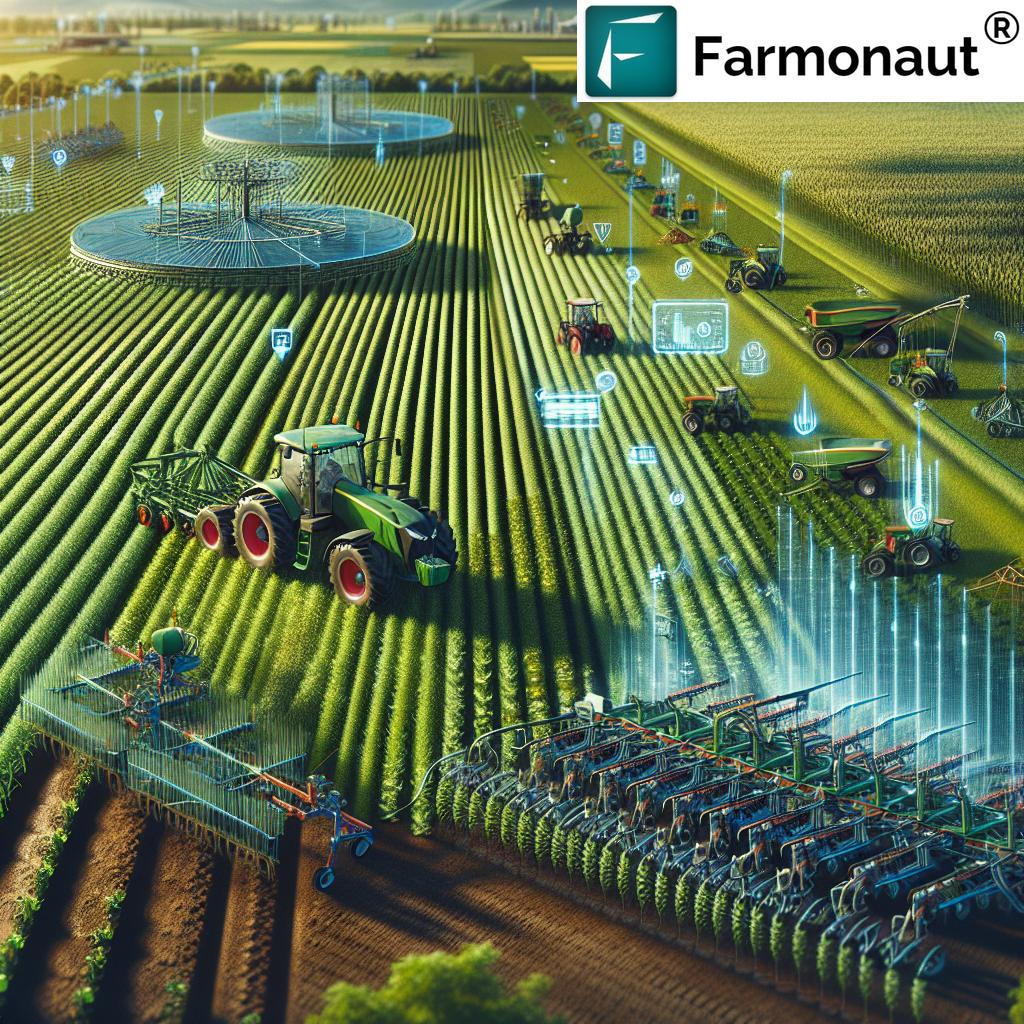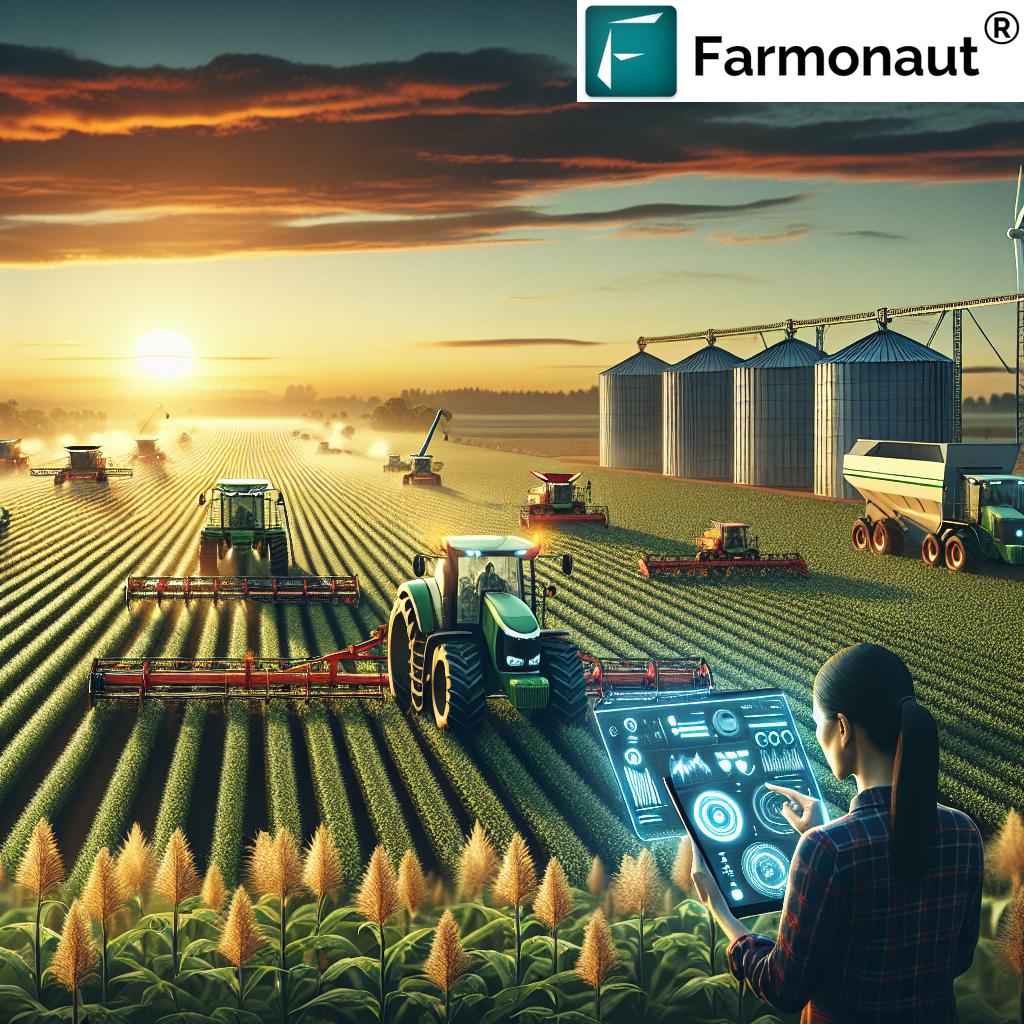“By 2025, over 30% of large-scale farms use AI-powered centrifuges to streamline crop processing and resource efficiency.”
Understanding Centrifuges and the Role of Agriculture in 2025
Agriculture remains the cornerstone of human survival and economic development worldwide. It provides the food, raw materials, and jobs for billions of people. As our global population grows and climate challenges intensify, modern technologies, including centrifuges and artificial intelligence (AI), are increasingly being integrated into agricultural practices to enhance productivity, sustainability, and efficiency in 2025 and beyond.
This comprehensive article explores what is a centrifuge, how it is used in agriculture, the broader importance of agriculture, what agricultural land is used for, and critically, the role of AI in agriculture in 2025 with advanced technological context. We also look at how industry leaders like Farmonaut support these transformations with cutting-edge technology solutions.
Introduction
In the rapidly modernizing world of 2025, agriculture is being revolutionized by an array of innovative technologies. Among the most important are centrifuges—mechanical devices that separate substances of different densities—and artificial intelligence (AI), which brings machine learning, data analysis, and automation to the farm.
This article explores these subjects and how they answer vital questions like what is a centrifuge, how is it usedd in agriculture, what is the use of AI in agriculture, and what is agricultural land used for? Understanding these forces is crucial as we confront pressing challenges such as feeding a growing global population, managing natural resources efficiently, and ensuring environmental sustainability.
What Is a Centrifuge? Working Principle & Agricultural Applications
What is a Centrifuge and How Is It Used in Agriculture?
A centrifuge is a specialized mechanical device that applies centrifugal force by rapidly spinning containers filled with mixed samples. As the container spins, heavier particles move outward toward the edge of the container while lighter components stay closer to the center. This results in an effective separation of different densities within a mixture.
Centrifuges are commonly associated with laboratory use, but in 2025, they are gaining momentum in agriculture due to their ability to separate, analyze, and process biological and chemical components essential for food and crop science.
- Soil Analysis: Centrifuges are used primarily for separating organic and inorganic materials in soil samples. This aids in precise nutrient profiling and guides tailored fertilization strategies that are crucial for crop health and yield optimization.
- Seed Preparation: Centrifugal separation helps clean and grade seeds based on their density, ensuring that only healthy, viable seeds are used for planting.
- Agricultural Biotechnology: Centrifugation is applied to process plant extracts, isolate bioactive compounds, and support the development of biopesticides and biofertilizers by separating microorganisms or specific plant cells in research labs.
- Water Testing: Centrifuges can separate soil particles, organic material, or pathogens from irrigation and processing water for quality control.
- Biopesticide and Biofertilizer Production: Used in the production and purification of microbial and organic formulations that are more eco-friendly and resilient against pests and climate-related stresses.
Importantly, the use of AI-powered centrifuges now enables automated sample processing and real-time data analysis. 2025 agricultural laboratories and industry research centers heavily rely on such integrations for consistent, fast, and accurate results.
To learn how Farmonaut’s satellite and AI-powered tools bring a new edge to farm data monitoring and real-time analytics for soil and crop health, check out our full Web App platform.
Science Behind Centrifugation: How It Works
- Centrifugal Force: The primary force applied by a centrifuge that causes materials of different densities to separate.
- Spinning & Separation: As samples spin, more massive/heavier particles (e.g., soil minerals) move outward towards the periphery (sediment), while lighter substances (e.g., water, organic solution) remain near the center (supernatant).
- Efficiency & Accuracy: The rate and precision of separation depend on the rotational speed (RPM), duration, and design of the centrifuge (e.g., fixed-angle, swing-bucket).
Centrifugation helps isolate specific components for genomic, nutritional, or chemical analysis—supporting more precise agriculture and ultimately improving crop resilience and yield.
Farmonaut’s Jeevn AI Advisory System delivers real-time insights harnessing satellite data and machine learning to enhance precision, forecast fertilizer needs, and drive more sustainable resource use.
“Advanced centrifuge technology in 2025 processes agricultural samples up to 50% faster compared to traditional equipment.”
Comparative Table of Centrifuge & AI Applications in Agriculture (2025)
| Application Area | Traditional Centrifuge Methods (Processing time, accuracy, labor hours) |
AI-Integrated Centrifuge Methods (Estimated improvement) |
Estimated Cost Reduction (%) | Sustainability Impact |
|---|---|---|---|---|
| Soil Analysis | Processing time: ~60 min/sample Accuracy: 85% Labor: 0.8 hrs/sample |
Processing time: ~28 min/sample Accuracy: 95% Labor: 0.2 hrs/sample |
38–45% | High (Optimal fertilizer use, reduced runoff) |
| Water Testing | Processing time: 40 min/sample Accuracy: 80% Labor: 0.7 hrs/sample |
Processing time: 18 min/sample Accuracy: 92% Labor: 0.1 hrs/sample |
50–55% | Medium (Cleaner irrigation, less waste) |
| Seed Sorting/Preparation | Processing time: 90 min/batch Accuracy: 79% Labor: 1.2 hrs/batch |
Processing time: 38 min/batch Accuracy: 97% Labor: 0.2 hrs/batch |
58–62% | High (Better germination, less resource input) |
| Plant Extract/Bioactive Isolation | Processing time: 50 min Accuracy: 83% Labor: 1 hr/sample |
Processing time: 21 min Accuracy: 98% Labor: 0.2 hrs/sample |
60% | High (Purity, eco-friendly bioproducts) |
| Biopesticide/Biofertilizer Production | Processing: 120 min/batch Accuracy: 77% Labor: 1.5 hrs/batch |
Processing: 45 min/batch Accuracy: 96% Labor: 0.3 hrs/batch |
66% | High (Reduced chemical dependance) |
| Crop Disease Detection | Processing: 75 min/sample Accuracy: 80% Labor: 1 hr/sample |
Processing: 26 min/sample Accuracy: 97% Labor: 0.1 hrs/sample |
65% | High (Early detection, reduced spread/pesticide use) |
Agriculture: Its Importance for Food, Economy, & Survival
What is Agriculture and Why Is It Important?
Agriculture is the science, practice, and art of cultivating plants, raising livestock, and managing natural resources in order to produce food, fiber, fuel, and other essential products for life. But what is the use of agriculture and why has it remained a cornerstone of civilization for millennia?
- Ensuring Food Security: Modern agriculture, supported by AI and centrifuges, provides reliable food production to support a worldwide population now exceeding 8 billion.
- Supporting Livelihoods: Agriculture remains a vital source of employment, economic development, and survival, especially in rural areas.
- Supplying Raw Materials: The sector supplies raw materials for textile (fiber), food processing, energy, and more.
- Maintaining Ecosystems: Sustainable agricultural practices are essential to conserve soil, maintain carbon cycles, and promote climate resilience.
- Driving Innovation and Sustainability: Increasingly integrated technologies like satellites, AI, and advanced laboratory equipment reduce environmental impacts and enhance productivity.
The evolution of modern agriculture—from traditional plowing to advanced robotics and data analytics—demonstrates the importance of asking: What is agriculture and why is it important? It’s because it underpins all economic, social, and environmental pillars of a thriving world.
Key Uses of Agriculture Today and in 2025
- Food Production: Direct cultivation of cereals, pulses, vegetables, and fruits
- Livestock Raising: Breeding of cattle, sheep, poultry, and fish for protein
- Fiber Production: Cotton, hemp, jute, and other textile crops
- Biofuel Generation: Sugarcane, corn, and algae are managed to help produce energy and fuel
- Forestry and Plantation: Sustainable management of trees for timber and soil health
- Ecosystem Services: Farmers help reduce deforestation, conserve biodiversity, and restore land by integrating carbon footprint monitoring and blockchain traceability into agricultural practices
In 2025, advanced climate-smart practices and AI-powered advisory systems are essential for efficient, scalable, and sustainable agricultural production.
Explore the importance of regenerative and climate-smart solutions—core features in leading-edge platforms like Farmonaut’s carbon footprint tracking used worldwide by environmentally responsible producers.
Uses of Agricultural Land in 2025
What Is Agricultural Land Used For and Why Is It Critical?
Agricultural land is defined as the area designated for the cultivation of crops, fiber, and livestock grazing. But what is agricultural land used for in the rapidly changing landscape of 2025?
- Intensive Crop Production: Advanced soil and land management now allow multiple cropping cycles per year while reducing inputs and waste through precision farming.
- Vegetable & Fruit Farming: Controlled environments, vertical farming, and advanced greenhouses support year-round, high-nutrient food production.
- Pasture and Livestock: Sustainable grazing management for dairy and meat helps preserve grasslands and limit overgrazing.
- Agroforestry & Biodiversity: Integrating trees, shrubs, and cover crops on agricultural lands helps reduce erosion, sequester carbon, and support wildlife.
- Buffering Ecosystems: Well-managed agricultural land acts as a buffer to protect natural habitats and prevent soil and water degradation.
Due to rising food security and climate challenges, land management strategies in 2025 focus on efficient allocation and sustainable land-use planning. The Farmonaut Large Scale Farm Management platform empowers large and small farm operations to monitor, optimize, and report on land use via satellite data and analytics.
Key benefits include:
- Real-time land cover monitoring & alerts for unauthorized use or damage
- Detailed soil health mapping & NDVI (Normalized Difference Vegetation Index) analysis
- Guided resource allocation for maximum efficiency and yield
The Role and Use of AI in Agriculture for 2025
What Is the Use of AI in Agriculture Today?
Artificial intelligence (AI) is now a transformative force in agriculture. With AI-driven technologies becoming widely accessible, the role and use of AI in agriculture in 2025 are central to meeting urgent demands—higher productivity, smarter resource management, and greater sustainability.
- Data-Driven Decision Making: High volume data from sensors, weather stations, drones, and satellite imagery is analyzed by machine learning algorithms to suggest the best irrigation, fertilization, or crop protection actions.
- Pest and Disease Prediction: AI models process satellite and weather data to identify risks and deliver timely warnings, sharply reducing chemical use and crop loss.
- Precision Farming: Automated guidance for variable-rate fertilization and watering, reducing waste and cost.
- Automation & Robotics: Technologies now automate planting, harvesting, sorting, and packaging, relieving labor shortages.
- Real-Time Advisory: AI-powered platforms provide customized, actionable insights for farm management—available through web and mobile apps like Farmonaut’s
- Blockchain Traceability: Enhanced authenticity of produce, inputs, and farm processes—supported by blockchain-based traceability solutions.
- Climate Adaptation: AI-powered impact monitoring enables producers to adapt faster to changing weather, improve water management, and reduce carbon emissions.
Farmonaut leverages all these technologies to help farmers, enterprises, and governments worldwide use AI for advanced, affordable, and sustainable agriculture in 2025.
Major Benefits of AI in Agriculture
- Reducing Human Error and Manual Labor
- Improving Resource Efficiency
- Enhancing Food Security and Quality
- Enabling Traceability & Compliance
- Improving Environmental Sustainability
In summary, the use of AI in agriculture is enabling a revolutionary leap—addressing the environmental, economic, and social challenges of feeding our growing population.
Farmonaut’s Satellite & AI Solutions for Modern Agriculture
At Farmonaut, we are committed to making the most advanced satellite, AI, and blockchain solutions accessible worldwide. Our platform provides tools for real-time crop and land monitoring, automated advisories, and blockchain-based traceability solutions—affordable for farmers and scalable for large agribusinesses and governments.
- Satellite Crop Monitoring: Analyze crop health and soil vitality with NDVI, NDWI, and LAI mapping. Try our web and app platform.
- AI-Based Advisory: Our Jeevn AI delivers real-time, tailored advisories for productivity, irrigation, and climate-smart actions.
- Blockchain Traceability: Secure authenticity of food and agri-resources across supply chains. Learn more about product traceability.
- Fleet Management: Track all agri and logistics vehicles—cut costs, optimize resources. Explore our fleet management system.
- Crop Loan & Insurance Verification: Fast-track loan and insurance approvals using remote satellite audits. See our loan verification solutions.
- Environmental Impact Tracking: Monitor and report on carbon footprint and drive compliance with global sustainability norms.
- Large-Scale Farm Management: End-to-end resource, labor, and farm plot monitoring for robust compliance and reporting. Read about our large-scale farm management.
The Future: Integrating Advanced Technologies in Agriculture
In 2025 and beyond, the integration of centrifuges, AI, and satellite monitoring marks a new era in agriculture. These systems streamline everything from lab analysis to large-scale land management. The transformation is about more than just adopting tools—it’s about empowering sustainable food systems, nurturing ecosystems, and securing economic opportunity for billions worldwide.
- Smarter Resource Use: Advanced centrifuge and AI-driven lab systems reduce redundant inputs and provide precise, actionable insights.
- Climate-Smart Practices: Carbon reporting, traceability, and weather-adaptive planning ensure higher yields and long-term sustainability.
- Inclusive Growth: Affordable, app-based and API solutions democratize technology access for farmers, small businesses, and government agencies globally.
As we look toward 2030 and beyond, a unified ecosystem of data, intelligence, and connectivity—offered by platforms like Farmonaut—will be essential for maintaining food security, economic vibrancy, and environmental stewardship.
FAQ – Centrifuges, AI, and Agriculture in 2025
-
Q: What is a centrifuge and how is it used in agriculture?
A centrifuge is a mechanical device that uses centrifugal force to separate components of different densities in a mixture. In agriculture, it’s vital for precise soil nutrient profiling, seed health analysis, water testing, and development of biopesticides and eco-friendly inputs. -
Q: What is the use of agriculture in the modern world?
Agriculture provides the food, fiber, fuel, economic foundation, and environmental services that enable human survival and economic development worldwide. -
Q: What is the use of AI in agriculture?
AI powers data-driven farming, enabling real-time advice, automation, predictive analysis, better resource allocation, and improved sustainability and climate adaptation. -
Q: What is agricultural land used for?
Agricultural land is used for crop cultivation, livestock grazing, agroforestry, protecting natural ecosystems, and supporting rural economies and food security. -
Q: How do AI and centrifuges together improve agriculture?
AI-integrated centrifuges process samples faster, more accurately, and support large datasets for research, allowing precision fertilization, efficient water use, better disease detection, and faster bioproduct development. -
Q: Where can I access AI-powered agricultural monitoring solutions?
Platforms such as Farmonaut provide real-time crop monitoring, AI-based advisory, carbon footprinting, and blockchain-based traceability for all scales of farming through web, Android, and iOS applications, as well as APIs for integration. -
Q: What is the impact of advanced centrifuge technology on sustainability?
Advanced centrifuges, when paired with AI, cut down the processing time and increase accuracy, reducing chemical/fertilizer overuse, promoting eco-friendly inputs, and accelerating regenerative agricultural practices.
Farmonaut Subscription Plans
Access the latest tools in satellite-driven crop monitoring, AI advisory, and blockchain traceability for your agricultural needs. Start today—scale smarter, manage risk, reduce costs, and lead the change in sustainable agriculture.
Conclusion
The modernization of agriculture in 2025 is a direct result of seamlessly integrating centrifuges, AI-driven analytics, and satellite monitoring into every stage of the farm-to-food chain. Centrifuge technology provides essential, precise biochemical and soil analysis, while AI and machine learning platforms optimize every decision for yield, cost, and environmental stewardship.
At Farmonaut, we are proud to be at the forefront—making these advanced, sustainable, and data-driven agricultural solutions accessible and affordable worldwide. As agriculture continues to adapt to the twin challenges of a growing population and evolving climate conditions, technological innovation will remain key to resilient food systems, thriving landscapes, and sustainable rural livelihoods.
Empower your farm, your business, and your world with the cognitive power of modern technologies—choose the right tools for today and tomorrow’s agriculture with Farmonaut.













